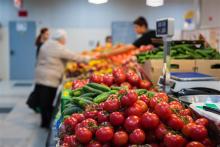- Read more about Strawberry lemon cheesecake
- Log in or register to post comments

- Read more about Delicious and very easy recipe!
- Log in or register to post comments

- Read more about What do you do with the lemon
- Log in or register to post comments


When you hear someone say that you will need to exercise, it may feel overwhelming. One of the healthy lifestyle strategies of diabetes management is to participate in physical activity or body movement. The Standards of Care in Diabetes recommends people with diabetes engage in physical activity regularly, including 150 minutes per week of aerobic exercise along with participating in resistance and flexibility activities 2–3 times per week.


Eating balanced meals with plenty of vegetables is one of the best things you can do to help manage diabetes. However, this can be hard to do when a healthy choice is more expensive than the not-so-healthy one. The good news? There are options out there to help you with food costs.

 Whether you're cooking for yourself or looking to whip up a quick dish for yourself and someone else, check out these recipes for one or two people. These quick and easy recipes are perfect for a healthy, diabetes-friendly meal.
Whether you're cooking for yourself or looking to whip up a quick dish for yourself and someone else, check out these recipes for one or two people. These quick and easy recipes are perfect for a healthy, diabetes-friendly meal.

- Read more about Excellent Dinner
- Log in or register to post comments

- Read more about FAT?
- 1 comment
- Log in or register to post comments


Cooking meals at home is a great way to save money and eat healthy. And using ingredients that cost less in your meal planning will help you save even more. Items like canned or frozen vegetables (get the no salt added options), dried or canned beans, canned tuna, rotisserie chicken, eggs, pasta, grains, and potatoes. Plant-based proteins, like tofu, can also be budget-friendly.
Try a more relaxed way meal plan using ingredients that cost less this week because we did the work for you! Check out some of our favorite cost-saving, healthy recipes.
